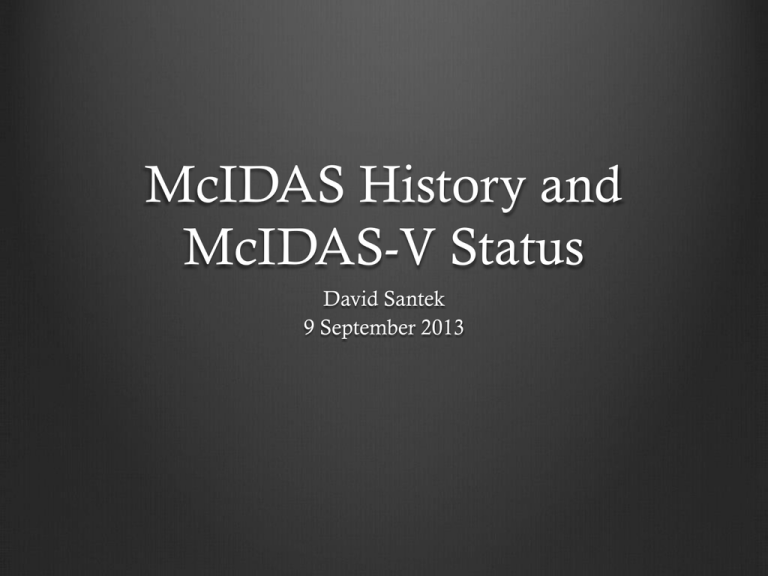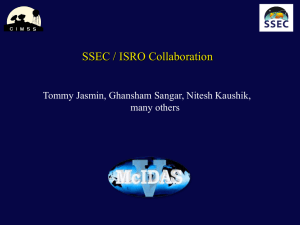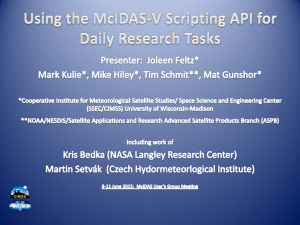McIDAS History and McIDAS-V Status David Santek 9 September 2013
advertisement

McIDAS History and McIDAS-V Status David Santek 9 September 2013 McIDAS History 1960s: Prof. Vern Suomi was striving to exploit the geostationary satellites for time domain information McIDAS was initially developed with the goal to mass produce the cloud drift winds For the last 40 years, McIDAS has evolved through 5 generations of hardware/software as an internationally renowned system McIDAS Significant Milestones 12 October 1973: McIDAS was first used in a research project by Dave Martin 1977: McIDAS installed at WTVT in Tampa, FL; continues as an active McIDAS site today 1978: Cloud-drift winds were manually generated from five geostationary satellites for a year as part of the First GARP Global Experiment (FGGE) McIDAS Significant Milestones 1979: Congressional delegation visited SSEC to learn about advances in severe storm forecasting in wake of tornadoes in Wichita Falls, TX 1982: McIDAS installed at NSSFC to aid in severe weather forecasting. Mesoscale Discussions began in 1986, partly in response to the availability of timely analyses 1982: Port to mainframe; funded by People’s Republic of China McIDAS Significant Milestones 1982: Interactive Flash Flood Analyzer (IFFA) based on McIDAS installed at NOAA 1989: McIDAS Users’ Group formed mid-1980s: McIDAS installed at Cape Canaveral and Johnson Space Center in support of the space shuttle late-1980s: Installed at NHC McIDAS Significant Milestones 1992: McIDAS-X, Unix-based system 1994: CIRA RAMSDIS – GOES satellite data into NWS mid-1990s: Abstract Data Distribution Environment (ADDE) McIDAS-X Current Chapter McIDAS-X Introduction Ported code from mainframe and DOS- and OS/2-based computers to IBM AIX workstations Released April 1992 A distributed system as opposed to previous mainframe McIDAS-X Keys to Success Port to Unix ADDE (Abstract Data Distribution Environment) McIDAS-X Reglue Resulted in the longevity of McIDAS-X Reliability, Stability Solid infrastructure McIDAS-X Future McIDAS-X is expected to be supported until about 2020 for current GOES satellites NOAA/NESDIS has a million lines of product generation code MUG bug fixes, adaptive maintenance (changes to and new satellites) Enhancements continue to be funded and/or code contributed by internal projects and external sites McIDAS-V Motivation McIDAS-X software (currently written in Fortran 77 and C) has a 40-year heritage resulting in limited extensibility potential New visualization concepts cannot be incorporated Forthcoming environmental satellite data cannot be utilized efficiently (GOES-R & JPSS operational systems) McIDAS-V Goals McIDAS-V shall be a powerful and versatile software system for environmental data processing, analysis and visualization McIDAS-V shall support existing and evolving needs of scientific research and algorithm/applications development for new programs, such as NPOESS and GOES-R as well as for retrospective data, such as that from GOES and POES McIDAS-V shall support data fusion and algorithm interoperability from existing and future sources The McIDAS team shall continue to fully support the MUG and McIDAS-X functionality as users transition to McIDAS-V McIDAS-V shall support operational users by providing tools and interfaces that enable a natural transition path for research results into operations McIDAS-V shall be used to educate students in remote sensing and physical sciences, and students must be integrally involved in its development, evolution and use McIDAS-V Innovative Develop new capability in visualization and data analysis: Move beyond 2D to 3D McIDAS-V Innovative McIDAS-V Milestones 2003: Whittaker and Santek present a McIDAS-V plan to the Directors 2006: Investigations of a “new approach” to data analysis and visualization 2007: Collaboration with Unidata to advance VisAD and IDV as the basis of McIDAS-V 2008: McIDAS-V becomes an “alpha” January 2009: beta 1 January 2010: beta 5 September 2010: V1.0 McIDAS-V Current Users In 2012: McIDAS-V was downloaded by 4600 unique IP addresses McIDAS-V was launched 340,000 times (lifetime total of over 1,000,000) Education (AOS, Texas A&M, MissState, etc.) Real-time: EUMETCast users Automated: Mexico weather service McIDAS-V Survey Fall 2012: A survey was created for users of McIDAS software. December 2012: The survey was sent to: Those on McIDAS email lists A large group of scientists where it was uncertain if they ever used McIDAS There were 69 responses to the McIDAS-V portion of the survey; about a 10% response. McIDAS-V Survey Usage Important attributes 41% used McIDAS-V and not McIDAS-X 89% wide variety of data types 59% used both 74% imaging and animation tools 41% used the software at least once a week 67% responders were in research; 30% in operations 89% used satellite data (88% geo; 44% polar) 74% overlay multiple data types 70% ease of use 59% analysis tools McIDAS-V Software Status Four main components: VisAD IDV HYDRA Additional development McIDAS-V Software Status: VisAD VisAD is an open-source, Java library for building interactive and collaborative visualization and analysis tools: Mathematical data model that embraces any numerical data set General display model that supports 2- and 3-D displays, multiple data views, direct manipulation Adapters for multiple data formats and access to remote data servers McIDAS-V Software Status: IDV IDV built on VisAD (User Interface, etc.) The IDV is maintained by Unidata, with input and suggestions from SSEC Monthly telecons between Unidata and SSEC Shared programmer forums Common source control Includes the netCDF Java library for reading many different data formats (netCDF, HDF, GRIB, BUFR, etc.) McIDAS-V Software Status: HYDRA HYDRA: HYperspectral viewer for Development of Research Applications Multi- and hyper-spectral data viewer and analysis package Not yet fully integrated with McIDAS-V Does not work with all data types User Interface is different McIDAS-V Software Status New User Interface built on VisAD and IDV The top-level McIDAS-V software and interface is maintained by the MUG programmers and others. A new scripting capability was developed, replacing that in IDV Current version: 1.3 McIDAS-V Suomi NPP VIIRS McIDAS-V Suomi NPP CrIS McIDAS-V Future Continue to engage younger generation: Workshops and training Classroom Appeal to researchers: More data fusion Move beyond 2D world Address technical and programmatic issues through a review process: Engage additional SSEC developers and researchers Evaluate current state and map a plan for future McIDAS-V Review Technical Identify current technical issues Anticipate future issues Plan a technical direction Programmatic Coordinate internal funding sources Mechanism for McIDAS-V infrastructure improvements

